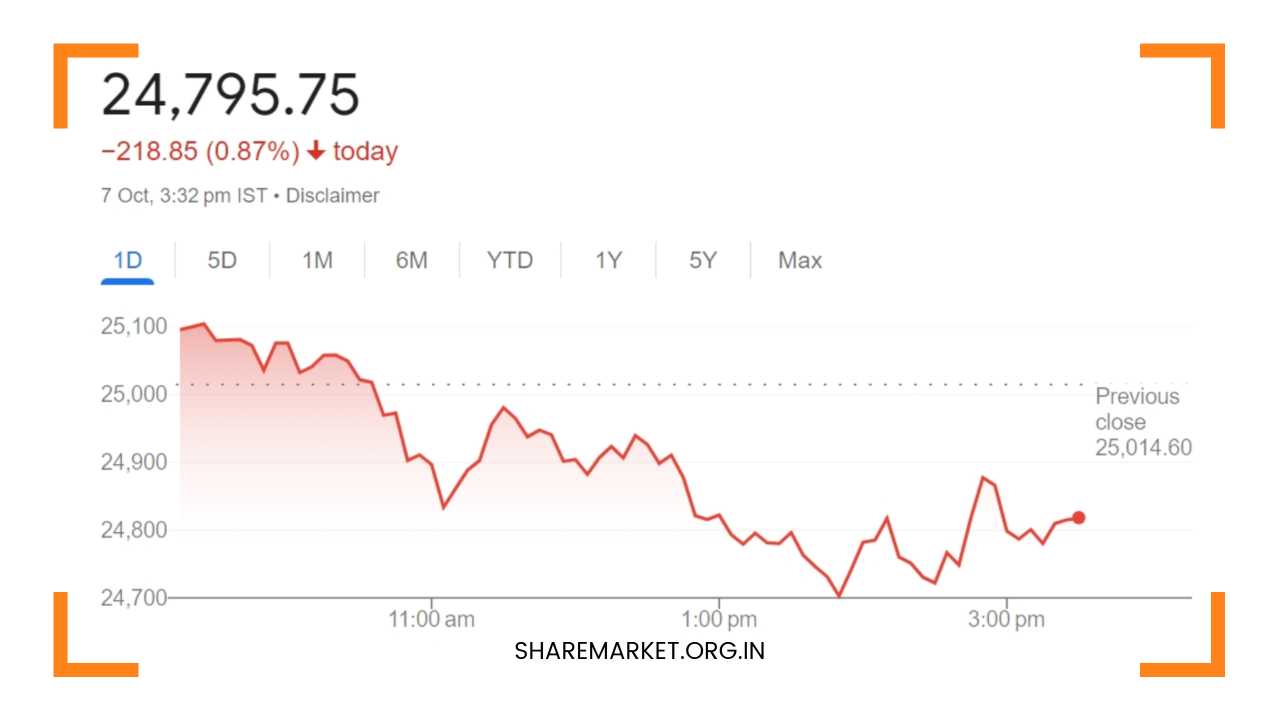Nifty Closed Below 24800; Tomorrow Nifty Prediction

Tomorrow Nifty Prediction
Nifty Closes Below 24,800 – Insights and Expectations for October 8
The Indian stock markets experienced a tumultuous trading session on October 7, marked by significant volatility and a downward trend.
The Nifty index, a benchmark for Indian equities, closed below the critical psychological support level of 25,000, settling at 24,795.80—a decline of 218.80 points or 0.87%. Similarly, the Sensex ended the day at 81,050.00, down 638.45 points or 0.78%.
The trading session highlighted a stark disparity in market breadth, with only 597 stocks advancing against 3,289 that declined, while 117 stocks remained unchanged.
This indicates a challenging environment for investors, with a clear preference for cash preservation over risk exposure.
Sector Performance: Winners and Losers
The session was characterized by pronounced losses among key heavyweights. Stocks such as NTPC, Adani Ports, Adani Enterprises, SBI, and Coal India were among the top losers in the Nifty index.
This decline in major stocks can often set a bearish tone for the broader market, creating a ripple effect that can lead to increased selling pressure.
In contrast, several stocks managed to defy the downward trend. ITC, Bharti Airtel, Trent, M&M, and Infosys were notable gainers, demonstrating resilience amid a generally unfavorable trading environment. However, these gains were not enough to offset the losses seen across most sectors.
From a sectoral perspective, all indices except for Information Technology, which saw a modest rise of 0.6%, closed in the red.
The most significant declines were observed in the PSU banks and media sectors, both of which fell by 1% to 3%. The BSE midcap index plummeted by 2%, while the smallcap index experienced a sharper decline of over 3%.
This broad-based selling pressure underscores the cautious sentiment prevailing among investors.
Technical Analysis: Bearish Signals
Market analysts are closely observing the technical indicators following this session of sharp declines. Aditya Gaggar, Director at Progressive Shares, described the day as a “roller-coaster ride,” noting that after a strong initial opening, the index quickly faced selling pressure, particularly from mid and smallcap stocks.
The Nifty index formed a series of bearish candles, including a three-black-crows pattern on the daily chart, signaling potential continued weakness.
For any signs of recovery, the Nifty must demonstrate a strong and sustainable move above the 25,000 mark.
Until then, the market is likely to remain under the influence of bearish sentiment, with the next support level for Nifty observed at 24,400. If this level is breached, it could lead to further declines, raising the specter of increased volatility in the coming days.
Investor Sentiment: The Impact of External Factors
The current market sentiment is being significantly influenced by external factors, including high valuations and the withdrawal of foreign funds.
Prashant Tapase of Mehta Equities pointed out that these dynamics are causing investors to pull back, particularly from sectors that have previously been perceived as strong, such as banking, metals, telecom, and oil and gas.
This shift indicates a cautious approach among investors, who may be prioritizing capital preservation in an increasingly uncertain economic landscape.
Additionally, adverse exit poll results from two key states have further dampened investor enthusiasm towards the ruling government at the Center.
Such political uncertainties can often lead to volatility in the stock markets as investors reassess their positions based on anticipated policy changes that could arise from election outcomes.
Broader Market Context: Comparing with Asian Indices
While the Indian markets grapple with these internal challenges, it’s worth noting that other Asian indices are displaying bullish tendencies.
For instance, indices from countries like Japan and South Korea have shown resilience, leading to speculation that investors may seek opportunities in these markets, potentially diverting funds away from India.
This trend can further exacerbate the challenges faced by Indian equities, as capital flows shift toward regions perceived as more stable or favorable.
Future Expectations: What Lies Ahead?
As we look ahead to October 8 and beyond, traders and investors must remain vigilant and well-informed.
The ongoing bearish trends necessitate careful analysis, particularly concerning how the market will respond to upcoming economic indicators and global cues.
In the coming week, several key economic data releases are scheduled, including inflation rates and manufacturing indices, which could provide critical insights into the health of the Indian economy and influence market movements.
Investors should also pay close attention to global economic developments, particularly in major economies like the United States and China.
Any significant shifts in monetary policy, interest rates, or economic performance in these countries can have a cascading effect on Indian markets, affecting investor sentiment and capital flows.
Final Remarks
In summary, the Indian stock market is currently navigating a challenging landscape characterized by high volatility and bearish sentiment.
With the Nifty closing below 24,800 and facing potential support at 24,400, market participants should exercise caution. A sustained recovery above 25,000 is essential for restoring bullish confidence.
As external factors continue to play a significant role in shaping investor sentiment, a comprehensive understanding of both domestic and global market dynamics will be crucial for navigating this turbulent period.
For investors, this environment presents both challenges and opportunities. Those who can identify undervalued stocks and sectors may find potential for gains once market sentiment stabilizes.
However, a prudent approach involving careful risk assessment and strategic positioning will be essential to weathering the ongoing market fluctuations.

















